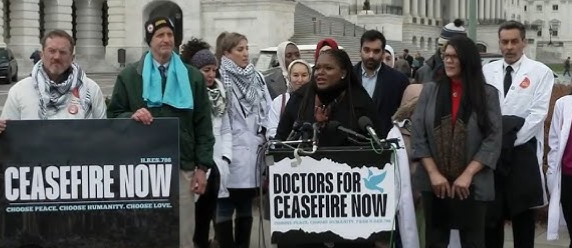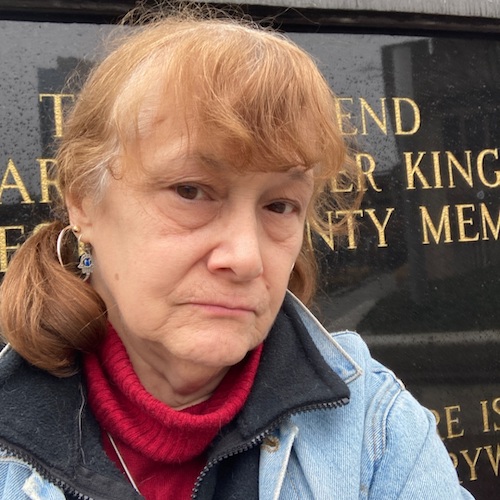Photos: NOOA\YouTube Screenshots\Wikimedia Commons
Obviously, climate change is not real. I’ve heard, you’ve heard, “expert” after “expert” telling us for years how climate change is a “fraud.”
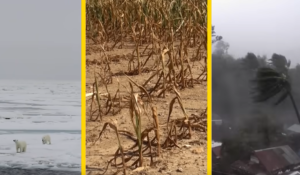
We’ve heard from our friends at the oil companies who made $196 billion in profits last year that the evidence for it is “inconclusive.” We’ve listened to politicians and pundits explain how proponents of climate change are engaged in “fake news,” are part of a “woke conspiracy” or pushing “cult-like” propaganda.
We’ve also heard that, perhaps, if the planet is warming it is part of some kind of natural occurrence which has nothing to do with human activity and the burning of fossil fuel.
What more can be said? Climate change is not real. Or, if it is, it has nothing to do with carbon emissions – and there is nothing we can do about it.
If this is what you believe I would respectfully disagree and I would urge you to get on the phone and call friends and family around the country to hear about what their communities are experiencing. I would also suggest that you check out (reliable) websites and take a look at what’s going on in virtually every part of the world. If you do, here’s what you’ll find.
The last eight years have been the eight hottest on record. This year is on track to be the hottest year in recorded history, and this past July was the hottest month in recorded history. Twenty-one of the 30 hottest days on record occurred this past month.
Across the United States, July broke more than 3,200 daily temperature records. Miami experienced its seven hottest days. Flagstaff, Arizona, and Brownsville, Texas, experienced their eight hottest days. At least 26 cities broke or tied their previous daily temperature records three or more times. Death Valley experienced the highest midnight temperature ever recorded on Earth.
Austin, San Antonio, Little Rock, Baton Rouge, Anaheim, Rapid City, Santa Fe, St. Paul, Corpus Christi, Sioux Falls, Fort Lauderdale, Reno, Helena, Grand Junction, Salt Lake City, San Juan, Tampa, Orlando, Fort Worth, Carson City, Portland – all of these cities experienced their highest temperatures on record.
It wasn’t just daily records. Phoenix recently experienced 31 days in a row at or above 110 degrees. El Paso experienced 44 days in a row at or above 100 degrees. Miami experienced a record 46 days at or above 100 degrees. Austin experienced a record 11 days at or above 105 degrees. Waco experienced a record 44 days at or above 100 degrees. Las Vegas experienced its hottest two weeks on record.
And it’s not just the United States. Dozens of locations in China experienced record-high temperatures last month, including the country’s all-time temperature record of 126 degrees. Rome, Cannes, Palermo, Tunis, Algiers, Tirana, Figueres – all of these cities across Europe and North Africa experienced their hottest days on record.
Cuba, the Dominican Republic, El Salvador – all saw multiple temperature records broken. Parts of the Middle East exceeded 150 degrees – near the most intense heat that the human body can survive. It’s winter right now in South America, but that hasn’t stopped temperatures from exceeding 100 degrees in some places.

And it’s not just that temperatures have been soaring on land. Our oceans have never been warmer. Right now, 44% of the world’s oceans are experiencing a marine heat wave. The Mediterranean Sea is experiencing its hottest temperatures on record, more than 9 degrees hotter than average in some places. South of Miami, waters reached 101 degrees. You’re supposed to find temperatures like that in a hot tub, not the ocean.
OK, so it’s hot. But how do we know this heat is so unusual? Couldn’t this just be part of a natural cycle going back millions of years? Is there really a link between extreme heat and human activity?
It is true that the Earth’s temperature does change a lot over millions of years. In fact, scientists believe that about 125,000 years ago it may have been even warmer than it is right now. What is disturbing, however, is that temperatures are rising much faster now than at any time in the past two million years.
Scientists look at a lot of things – gas trapped in ice, tree rings, glaciers, pollen remains, even changes in the Earth’s orbit – to study the natural changes in our climate going back millions of years. What these natural changes tell us is that it normally takes thousands of years for the earth to warm just a couple of degrees. The temperature increases we’ve seen in just the past century should have taken almost a thousand years.
Over the past 100 years, we’ve warmed the planet 10 times more quickly than anything we see in the natural record. Over the next 100 years, we’re on track to warm the planet 20 times faster than anything we see in the natural record. Bottom line: Our planet is warming up much more rapidly than in the past and entering into a very dangerous period for human well-being.
OK, so it’s hot and it’s getting hotter very quickly. What does this have to do with carbon emissions?
The answer is that scientists who look at the natural changes in our climate going back millions of years can see that temperature is closely linked to the amount of carbon in our atmosphere. Carbon goes up, temperatures go up.
And carbon is going up – carbon levels have increased 100 times faster than normal since the beginning of the industrial revolution. At the same time, global temperatures have increased nearly two degrees. What changed at the beginning of the industrial revolution? We began burning fossil fuels, which released a huge amount of carbon into our atmosphere. Carbon went up, and temperatures followed.
OK, so it’s hot and it’s getting hotter very quickly, and those rising temperatures are closely linked to the use of fossil fuels. What does this mean for us?

It means that rising temperatures create more flooding, extreme weather, droughts, wildfires and disease. And that means more human suffering, death, mass migrations and international instability. We’re seeing these impacts right now all around the world.
Near the end of last year, the United States experienced five 1,000-year flood events in five weeks. My state of Vermont just experienced its worst flooding since 1927 – damaging 4,000 homes. Canada is experiencing its worst wildfire season on record with smoke from Quebec creating unhealthy air conditions in large parts of the United States.
Last summer’s heat waves killed more than 60,000 people in Europe alone. Beijing recently recorded its heaviest rainfall in at least 140 years, forcing nearly one million people to relocate. Iran just announced a two-day public holiday, shutting down banks, schools and public agencies because of unprecedented heat which exceeded 123 degrees. In poverty-stricken African countries like Sudan, Madagascar and Somalia, drought and floods have cut food production, leading to a major increase in hunger.
Climate change will not only impact the physical well-being of humans, it will also have enormous economic implications. The Deloitte Economics Institute estimates that if left unchecked climate change could cost the global economy $178 trillion over the next 50 years as a result of lower productivity and employment, food and water scarcity and worsening health and well-being. We’ll also have to spend huge amounts of money repairing the damage that extreme weather causes.
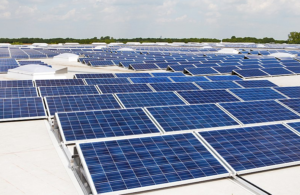
That’s the bad news.
The good news is that we can still avoid the worst impacts of climate change, save a great deal of money, and make our energy grid more resilient by transitioning away from fossil fuels toward renewable energy and energy efficiency.
Right now, wind and solar energy are the least expensive forms of new energy generation. Period. They’re cheaper than coal, and cheaper than natural gas. There is a reason why, despite enormous opposition from the fossil fuel industry, a conservative state like Texas has increased its solar capacity by more than 500% over the past three years.
Renewable energy also offers opportunities for families to save money. With rooftop solar, for example, you can generate electricity right at home and cut your electricity bills by 80% or more. That’s why I recently passed legislation to make it easier for low- and moderate-income families to install solar on their homes.
I understand that transitioning away from fossil fuels is a contentious and difficult issue and will meet enormous opposition from Big Oil and other special interests. I also understand that it is not just an American issue, and that China (currently the world’s major carbon emitter) and countries throughout the world will have to come together with us to make the cuts in carbon emissions that the health of the planet requires. Whether we like it or not, we’re all in this together.
While the path forward to a cleaner and more sustainable energy future for planet Earth will not be easy, and mistakes will certainly be made, the choice we face is pretty clear. Either we maintain the status quo and continue to see more heat waves, drought, floods and extreme weather disturbances or we move away from fossil fuels and do our best to make sure that the planet we leave our kids and future generations is healthy and habitable.
Frankly, this is not a difficult choice. This is a moral responsibility.
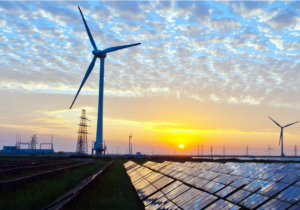

Senator Bernie Sanders represents the state of Vermont.




